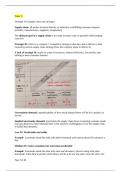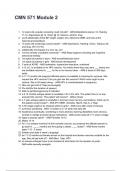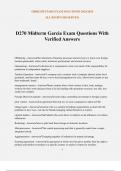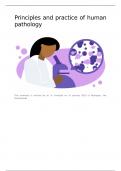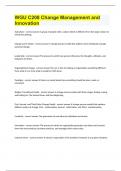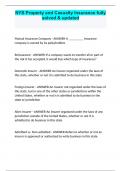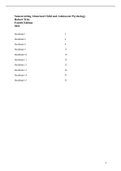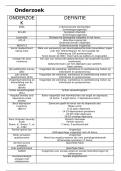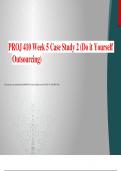HOOFDSTUK 2: HET MOLECULAIRE ORGANISATIENIVEAU
KEYPOINTS VAN DIT HOOFDSTUK
Atoomgetal Een element bestaat uit een specifiek aantal protonen =
atoomgetal
Atoom Kleinste stabiele eenheid van materie
Massagetal Het totaal aantal protonen en neutronen in de kern
Atoomgewicht Rekening gehouden met de relatieve percentages van de
verschillende isotopen van dat element
Isotoop Atomen van hetzelfde element waarvan de kernen verschillende
aantallen neutronen bevatten
Ion Atomen of moleculen die een elektrische lading hebben
Kation = ion met positieve lading
Anion = ion met negatieve lading
Stabiel atoom Atoom met volle buitenste schil geen interactie met andere
atomen (inert)
Instabiel Atomen met een niet-gevulde buitenste elektronenschil zijn
atoom instabiel ze zullen reageren met andere atomen tot ze een
volle buitenste schil hebben
Omkeerbare A + B AB
reactie Synthese- en afbraakreactie gebeuren tegelijkertijd in evenwicht
Enzym
Enzymen versnellen bepaalde biochemische reacties door de
activeringsenergie van de reactie te verlagen
Reguleren veel chemische reacties in het lichaam
Katalysator Verbindingen die chemische reacties mogelijk maken en daarbij
zelf ongewijzigd blijven
Bespreek Protonen en neutronen in de kern, elektronen in schillen rond
(teken) bouw de kern
van atoom
Maximaal aantal - Eerste = 2
elektronen op - Tweede = 8
elektronenschill - Derde = 18
en - Vierde = 32
3 chemische 1. Ionbinding
bindingen Chemische bindingen die ontstaan door de
tussen atomen/ chemische aantrekkingskracht tussen anionen en
moleculen kationen
Vb. Na+ en Cl- binden aan elkaar
2. Covalente binding
Atomen delen hun elektronen
Vb. Waterstof komt in de natuurlijk altijd als
waterstofgas voor (H2) / watermoleculen (H2O)
Altijd elektrisch neutraal
3. Waterstofbruggen
Aantrekking tussen een geringe positieve lading van
een positieve lading op het waterstofatoom en een
geringe negatieve lading opeen zuurstof of
stikstofatoom
Verschillende wateratomen trekken elkaar aan
= oppervlaktespanning (barrière)
KEYPOINTS VAN DIT HOOFDSTUK
Atoomgetal Een element bestaat uit een specifiek aantal protonen =
atoomgetal
Atoom Kleinste stabiele eenheid van materie
Massagetal Het totaal aantal protonen en neutronen in de kern
Atoomgewicht Rekening gehouden met de relatieve percentages van de
verschillende isotopen van dat element
Isotoop Atomen van hetzelfde element waarvan de kernen verschillende
aantallen neutronen bevatten
Ion Atomen of moleculen die een elektrische lading hebben
Kation = ion met positieve lading
Anion = ion met negatieve lading
Stabiel atoom Atoom met volle buitenste schil geen interactie met andere
atomen (inert)
Instabiel Atomen met een niet-gevulde buitenste elektronenschil zijn
atoom instabiel ze zullen reageren met andere atomen tot ze een
volle buitenste schil hebben
Omkeerbare A + B AB
reactie Synthese- en afbraakreactie gebeuren tegelijkertijd in evenwicht
Enzym
Enzymen versnellen bepaalde biochemische reacties door de
activeringsenergie van de reactie te verlagen
Reguleren veel chemische reacties in het lichaam
Katalysator Verbindingen die chemische reacties mogelijk maken en daarbij
zelf ongewijzigd blijven
Bespreek Protonen en neutronen in de kern, elektronen in schillen rond
(teken) bouw de kern
van atoom
Maximaal aantal - Eerste = 2
elektronen op - Tweede = 8
elektronenschill - Derde = 18
en - Vierde = 32
3 chemische 1. Ionbinding
bindingen Chemische bindingen die ontstaan door de
tussen atomen/ chemische aantrekkingskracht tussen anionen en
moleculen kationen
Vb. Na+ en Cl- binden aan elkaar
2. Covalente binding
Atomen delen hun elektronen
Vb. Waterstof komt in de natuurlijk altijd als
waterstofgas voor (H2) / watermoleculen (H2O)
Altijd elektrisch neutraal
3. Waterstofbruggen
Aantrekking tussen een geringe positieve lading van
een positieve lading op het waterstofatoom en een
geringe negatieve lading opeen zuurstof of
stikstofatoom
Verschillende wateratomen trekken elkaar aan
= oppervlaktespanning (barrière)


